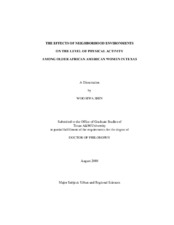| dc.contributor.advisor | Kweon, Byoung-Suk | |
| dc.contributor.advisor | Naderi, Jody Rosenblatt | |
| dc.creator | Shin, Woo Hwa | |
| dc.date.accessioned | 2010-01-15T00:12:33Z | |
| dc.date.accessioned | 2010-01-16T01:16:54Z | |
| dc.date.available | 2010-01-15T00:12:33Z | |
| dc.date.available | 2010-01-16T01:16:54Z | |
| dc.date.created | 2008-08 | |
| dc.date.issued | 2009-05-15 | |
| dc.identifier.uri | https://hdl.handle.net/1969.1/ETD-TAMU-3079 | |
| dc.description.abstract | The older African American women living Texas fall into one of the most
inactive population segments. Recently, the importance of socio-ecological models on
human health behavior and more complex associations between variables have been
discussed. Therefore, this cross-sectional study focuses on investigating the trends in
physical activity among older African American women, exploring the effects of actual
environmental variables that might encourage or discourage their physical activity, and
discovering any plausible mediating effects between environmental factors and older
African American women’s physical activity.
The study sample is composed of African American women aged 55 to 84 who
reside in independent housing in Bryan, Texas. A total of 282 older African American
women’s addresses were systematically selected and a self-administrated survey
questionnaire documenting the level of physical activity, psychological well-being, sense
of community, perception of safety, physical health status, and background information was collected for each of the women. The environmental influences of natural and built
environments were defined using two boundaries: 1) nearby home level (0.5 mile street
distance), and 2) neighborhood level (1 mile street distance) from the participant’s house.
The natural and built environments were measured using a Geographic Information
System (GIS) and aerial photographs.
Results showed that a) walking was the most prevalent type of physical activity
and streets were the most popular places for older African American women; b) at the
nearby home level, greenery and land use mixture were positively associated with older
African American women’s physical activity while street pattern and access to
commercial areas influenced their physical activity at the neighborhood level; and c)
perceptions of crime-related neighborhood problems had significant mediating effects
decreasing older African American women’s physical activity. The findings revealed
that the environmental variables had a distance effects on older women’s physical
activity. In addition, on a policy level, neighborhood problems should be dealt with
using careful insight in order to encourage physical activity. | en |
| dc.format.medium | electronic | en |
| dc.format.mimetype | application/pdf | |
| dc.language.iso | en_US | |
| dc.subject | Objective Natural and Built Environments | en |
| dc.subject | Neighborhood Problems | en |
| dc.subject | Mediating effects | en |
| dc.subject | Physical Activity | en |
| dc.subject | Older African American Women | en |
| dc.title | The effects of neighborhood environments on the level of physical activity among older african american women in Texas | en |
| dc.type | Book | en |
| dc.type | Thesis | en |
| thesis.degree.department | Landscape Architecture and Urban Planning | en |
| thesis.degree.discipline | Urban and Regional Sciences | en |
| thesis.degree.grantor | Texas A&M University | en |
| thesis.degree.name | Doctor of Philosophy | en |
| thesis.degree.level | Doctoral | en |
| dc.contributor.committeeMember | Ellis, Christopher D | |
| dc.contributor.committeeMember | Willson, Victor | |
| dc.type.genre | Electronic Dissertation | en |
| dc.type.material | text | en |
| dc.format.digitalOrigin | born digital | en |


